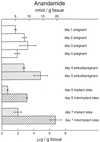Changes in anandamide levels in mouse uterus are associated with uterine receptivity for embryo implantation
- PMID: 9108127
- PMCID: PMC20598
- DOI: 10.1073/pnas.94.8.4188
Changes in anandamide levels in mouse uterus are associated with uterine receptivity for embryo implantation
Abstract
Anandamide (N-arachidonoylethanolamine) is an endogenous ligand for both the brain-type (CB1-R) and spleen-type (CB2-R) cannabinoid receptors. This investigation demonstrates that the periimplantation mouse uterus contains the highest levels of anandamide (142-1345 pmol/micromol lipid P; 1-7 microg/g wet weight) yet discovered in a mammalian tissue. The levels fluctuate with the state of pregnancy; down-regulation of anandamide levels is associated with uterine receptivity, while up-regulation is correlated with uterine refractoriness to embryo implantation. Anandamide levels are highest during the nonreceptive phase in the pseudopregnant uterus and in the interimplantation sites, and lowest at the site of embryo implantation. The lower levels of uterine anandamide at the implantation sites may be a mechanism by which implanting embryos protect themselves from the detrimental effects of this endogenous ligand. We also observed a reduced rate of zona-hatching of blastocysts in vitro in the presence of anandamide, and inhibition of implantation by systemic administration of a synthetic cannabinoid agonist CP 55,940. These adverse effects were reversed by SR141716A, a specific CB1-R antagonist. Taken together, the results suggest that an aberrant synthesis of anandamide and/or expression of the cannabinoid receptors in the uterus/embryo may account for early pregnancy failure or female infertility.
Figures

References
-
- Dewey W L. Pharmacol Rev. 1986;38:151–178. - PubMed
-
- Nahas G, Latour C. Med J Aust. 1992;156:495–497. - PubMed
-
- Rosenkrantz H. In: Marihuana: Biological Effects. Nahas G G, Paton W D M, editors. Oxford: Pergamon; 1979. pp. 479–499.
-
- Dalterio S, Battke A. J Endocrinol. 1981;91:509–514. - PubMed
-
- Asch R H, Smith C G. J Reprod Med. 1987;31:1071. - PubMed
Publication types
MeSH terms
Substances
Grants and funding
LinkOut - more resources
Full Text Sources
Other Literature Sources
Medical
Miscellaneous

